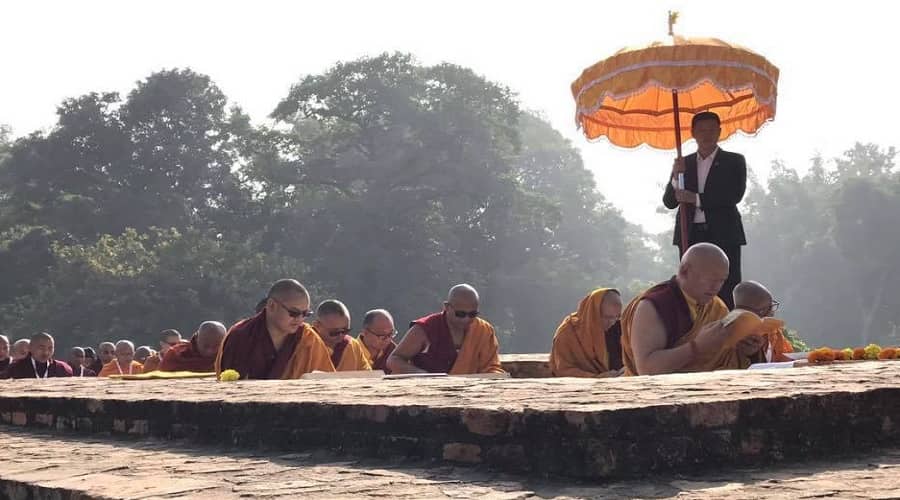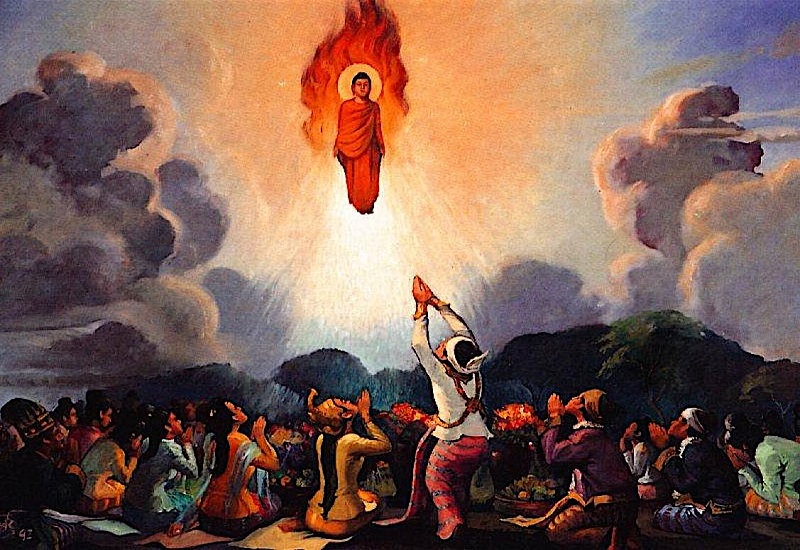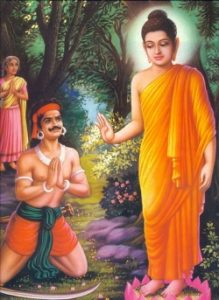Shravasti, known as Savatthi in Pali language, forms a crucial spot in Buddhist pilgrimage circuit of India. Its importance can be attributed to the fact that Lord Buddha spent about 25 years of his illustrious life in Shravasti, preaching the Noble path to the thousands of monks, householders and disciples who assembled to learn the way out of human suffering from the Enlightened Master. Shravasti was as materially prosperous as it was religiously and spiritually significant. Not only is Shravasti’s name associated with Lord Buddha’s life, but it is also known for being the birthplace of Sambhavnath and Chandraprabha, the great Jain Tirthankaras. The Jetavana Vihara, located in the outskirts of the city, emerged as one of the greatest spiritual sanctuaries of Buddha’s time imparting the timeless spiritual knowledge of the Dhamma to innumerous seekers from all walks of life. One can read the interesting account of Jetavana park being donated to Buddha by the munificent merchant-turned-disciple Anathapindika later in the article.

The remains of the historical city have been unearthed from Saheth and Maheth, the twin villages located northwest to Balrampur in northeastern Uttar Pradesh. Extensive archeological expeditions have been conducted by Archeological Survey of India in the land revealing relics that belong to three different historical periods.
History of Shravasti
The city of Shravasti was one among the six largest cities in ancient India. Founded by Shravasta, the Vedic Period King, the city is said to have been ruled by Lord Rama’s son Lava. In terms of population, the city overshadowed even the capital of Magadha at Rajgir. Shravasti served as the capital of Kosala Kingdom from 6th century BCE till 6th century CE. Emperor Ashoka had built two pillars and a Stupa in Shravasti. The city finds itself mentioned in the travel accounts left by Chinese travelers Hiuen Tsang and Fa-Hien. The city was subsequently lost to human history in the twelfth century. It was in 1863 that Alexander Cunningham unearthed the ruins of the ancient city of Shravasti from excavations conducted in Saheth and Maheth.
Historical narratives mention a vast fort covering the city. Even today, a huge rampart encircles the city. Archeological expeditions have unearthed many inscriptions, idols and other relics near the city premises. The most prominent of these remains are those of a monastery and Stupa at Saheth and a 5.2 km long mud fortification at Maheth. House complexes, ring wells, ruins of a Panchayatana temple, numerous terracotta human and animal figurines along with coins (silver, copper, Ayodhya and Kushana) form the other major remnants history has left in the city premises.
Jetavana Monastery – Ancient Buddhist Vihara
Jetavana, perhaps the most famous of Buddhist Monasteries during his lifetime, was the second to be donated to the spiritual teacher for the purpose of propagation of his spiritual teachings. In fact, the monastery held the sacred space for deliverance of most of his spiritual discourses and teachings. Lord Buddha is said to have spent considerable portion of his life in the Buddhist monastery of Jetavana. Accounts suggest that Buddha used to alternate between spending time at Jetavana and Migaramatupasada, another Vihara located nearby, during his stay at Shravasti- spending his days at Jetavana and nights at Migaramatupasada.
One comes across the remains of the Buddhist Vihara in the historical park at Jetavana today. Most revered of these is the Gandhakuti monastery, the holy ground in which Lord Buddha used to stay while at Jetavana. Many Stupas, huts and remains of monasteries can also be found inside the historical park of Shravasti. Also, the second of the most revered trees in Buddhism – Ananda Bodhi tree- is also located inside Jetavana. The tree is said to have been a direct descendent of the Bodhi tree in Bodhi Gaya under which Siddhartha attained enlightenment. It was planted by Buddha’s favourite disciple Ananda (hence the name!).
Buddhist accounts narrate a very interesting tale behind the conception of Jetavana Vihara. As per it, Anathapindika, an ardent devotee of Buddha sought to procure the land from its owner Jetakumara who declined to sell it even if the land was paid for in the amount of gold it would take to cover its area. Seeing Anathapindika’s resolve and generosity in willing to cover the land in gold sheets to procure it from him, Jetakumara agreed to offer it. The money he was offered in exchange for the land was used by Jetakumara to build the most magnificent of gateways for the monastery. Lord Buddha urged that the vihara be always referred to as Jetavane Anathapindikassa arama, such that the noble example of their generosity would live on and inspire others to contribute wholeheartedly to the cause of the noble spiritual path of Dhamma.
It is to be noted that Anathapindika was the reason behind Buddha’s coming to Shravasti. In fact, the wealthy merchant known for his munificence even before his adopting the Buddhist path met Lord Buddha at Rajagaha. He was so deeply moved by the profundity of the master’s teachings that he adopted the Buddhist path in the first meeting itself. The Master accepted the disciple’s invitation to visit Shravasti. Anathapindika recognized the park of Jetakumara to be the ideal site in which Buddha and his many disciples could quietly dwell and engage in their spiritual practices. So deep was his conviction in Buddha’s teachings that he didn’t think twice before spending such large sum of money for the purchase of the land, which would later bloom into one of the greatest spiritual sanctuaries of the time.
What is the Twin Miracle?

When prompted by somebody to perform miracles, Lord Buddha is said to have responded ‘I dislike, reject and despise them’. In spite of Lord Buddha’s encouragement of a healthy skeptical attitude in sincere spiritual practitioners, Buddhist narratives portray many tales of miracles associated with Buddha’s life. Foremost among them would be the twin miracle that is said to have occurred in Shravasti, the then capital of the kingdom of Kosala.
Shravasti was an established centre for philosophical and intellectual inquiries much before Lord Buddha set foot in its premises. Inevitably, Shravasti witnesses several debates and discussions between different schools of thought and Buddhist philosophy. In order to confound skeptics who could not be won over by reason, Lord Buddha performed what came to be known as the Twin miracle here. This involved such supernatural feats like levitating above the witnesses, letting flames of fire to emanate from one’s upper half while water streamed from his lower half, followed by reversal of the process. The astonished spectators then witnessed fire emanating from the right half of his corporeal body while water showered from his left-half. This was followed by emission of six brilliant light rays from Lord Buddha’s body. The astonishing feat ended with rain showering from the sky, which wetted only those who wished to and left the others totally dry.
Conversion of Angulimala into a Buddhist Monk

The famous story in the Theravada tradition of a ruthless brigand being converted into a Buddhist monk took place in Shravasti. This greatest of the miracles recorded by Buddhist narratives is a testimony to Buddhism’s firm belief in the fundamental goodness of every human being and the redemptive potency of Lord Buddha’s teachings.
Tourist attractions in Shravasti
- Vibhuti Nath Temple – The famous Shiva Temple in Shravasti attracts thousands of pilgrims from around the nation.
- Angulimala Stupa, Anathapindika Stupa
- Jetavana Monastery Park with Ananda Bodhi Tree and Gandha Kuti Hut
- Stupa of Twin Miracle
- Shobhnath Jain Temple
- The many monasteries constructed by Buddhist countries like Tibet, China, Myanmar, South Korea, Thailand and Sri Lanka to commemorate the spiritual sanctity of the land.
How to Reach Shravasti
The nearest airport is located at Lucknow. It is a 170 km drive from the airport till Shravasti.
If you prefer travelling by train, deboard at Balrampur, situated at a mere 17 km distance from Shravasti. But you might find that the nearby Gonda station offers better connectivity to most cities in the country.
One can easily reach Shravasti by road. Gonda Bus Terminus, located 50 kms away, has buses plying between Gonda and cities of Uttar Pradesh like Bareilly, Kanpur, Agra, Allahabad and Mathura.


